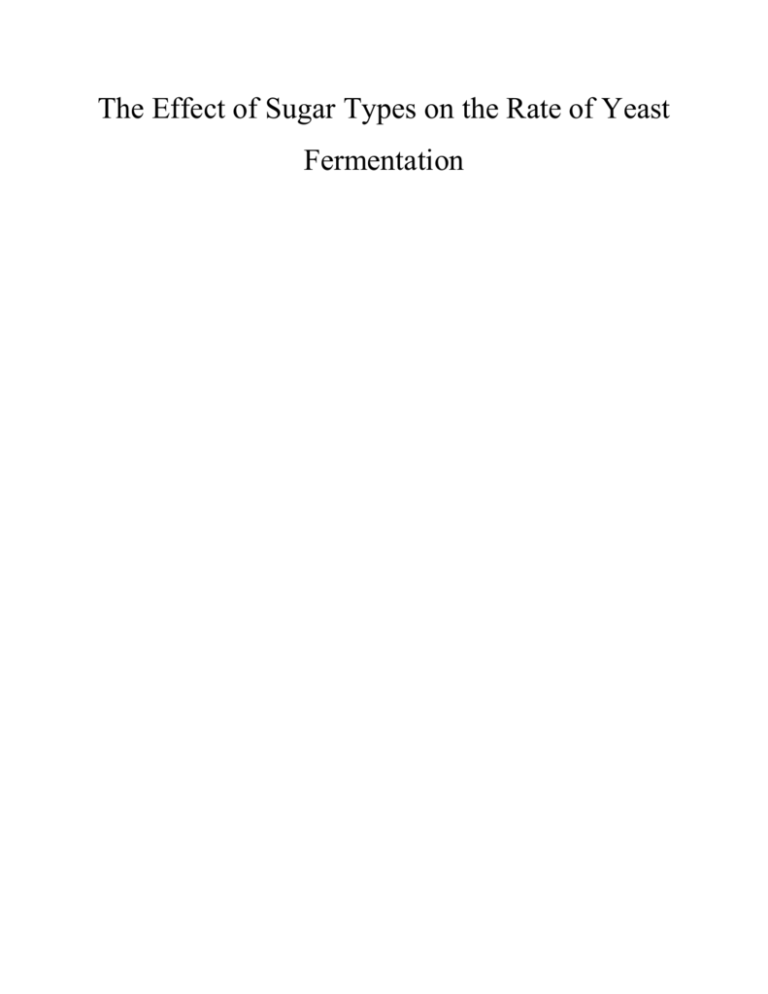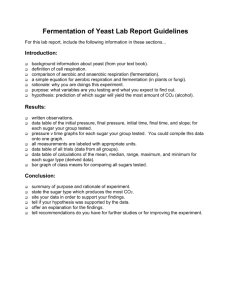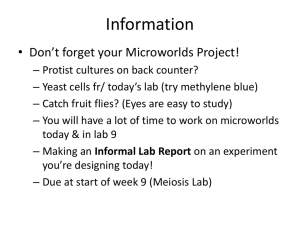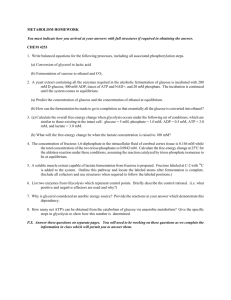
The Effect of Sugar Types on the Rate of Yeast
Fermentation
Abstract
In pairs, the biology class conducted a one-experiment study regarding the effect of
different sugars, as food sources for yeast, on the speed of fermentation. The experiment called
for six test tubes, each with different solutions: yeast-sucrose, yeast-fructose, yeast-glucose,
yeast-lactose, yeast-maltose, and yeast-water. The class hypothesized that glucose will
significantly increase the speed of fermentation of yeast, compared to the other sugar solutions.
Throughout the experiment, the students calculated the amount of CO2 bubbles per minute in
order to compare the speed of fermentation between the control group (water solution) and the
experimental groups (sugar solutions). The data gathered during the experiment exhibited that
yeast with glucose and fructose food sources will have a faster speed of fermentation compared
to the yeast with sucrose, lactose, maltose, and water food sources.
Introduction
Fermentation is the pathway following glycolysis, a metabolic process in cellular
respiration in which cells create ATP. Unlike the Krebs cycle, glycolysis and fermentation are
anaerobic processes, meaning that they do not require the presence of oxygen to occur. Types of
fermentation include alcoholic fermentation and lactic acid fermentation. Similarly, both
alcoholic and lactic acid fermentation require pyruvic acid and NADH as reactants (Levine and
Miller, 2010). However, alcoholic fermentation produces ethanol, NAD+, and carbon dioxide,
whereas lactic acid fermentation produces NAD+ and lactic acid. Fermentation is vital for many
organisms, such as yeasts, certain molds, and bacteria, because it allows them to obtain energy
required to carry on life processes. Alcoholic fermentation is especially important for human
beings, as it is used to produce alcoholic beverages, bread, and many other everyday items (AlbaLois, 2010). On the other hand, lactic acid is a waste product of certain bacteria, which is
utilized to create cheese, yogurt, sour cream, and many other important industrial items.
Additionally, humans resort to lactic acid fermentation when oxygen is limited. Bacterial
fermentation is also used in the medical industry to create certain antibiotics. Yeast, a singlecelled organism that utilizes sugar as a food source, produces energy substances through the
breakdown of sugar molecules.
Specifically, the type of sugar as source of food, impacts the speed of fermentation in
yeast. In this lab, we will calculate the rate of fermentation in yeast with different solutions of
sugar, such as sucrose, fructose, glucose, lactose, and maltose, with water as a control group. It
is important to humans that yeast uses the best sugar source during fermentation, as it creates
industrial items such as bread, alcohol, and yogurt. If the type of sugar source affects the rate
speed of fermentation, when you add glucose to a yeast solution, it will cause fermentation to
occur at a quicker rate.
Materials
● 6 large test tubes
● 6 disposable plastic pipettes
● 2 washers, nuts (weight) to fit on pipette stem
● labels
● stop watch
○ yeast solutions
○ yeast-sucrose
○ yeast-fructose
○ yeast-glucose
○ yeast-lactose
○ yeast-maltose
○ yeast-water (control group)
Procedure
1. Label the six test tubes, using the labeling tape, with the name of the six yeast solutions:
sucrose, fructose, glucose, lactose, maltose, and water.
2. Fill the bulb section of a pipette with the yeast-sugar solutions. To fill the pipettes, pull up as
much liquid as possible into the stem by squeezing the bulb completely and then slowly releasing
it. Turn the pipette upside-down and tap the pipette to move the liquid into the bulb. Keep the
pipette upside down. Make sure there is no solution in the stem of the pipette. Repeat the
procedure for all 6 solutions.
3. Attach to the pipette stem just above the bulb.
4. Fill each of the test tubes 2/3 with warm water (about 37 degrees Celsius)
5. Place each pipette (still upside down) into test tube #1. The pipette should be completely
covered by water and have about 2 to 3 cm of water above the tip.
6. You should observe tiny bubbles being released from the tip of the pipette. Count the number
of bubbles released over a period of 10 minutes and record your results. What gas is being
released? Carbon dioxide.
7. Repeat steps 2 to 4 for each of the remaining solutions. Record your observations for each.
8. Collect data from the class and calculate the average number of bubbles produced by each
solution.
Results
a. The dependent variable of the experiment is the rate in which yeast is fermented,
measured in bubbles produced in the test tubes (number of bubbles/minute).
b. The independent, or manipulated variable in the experiment is the type of sugar used in
the test tube: sucrose, fructose, glucose, lactose, and maltose.
c. The confounding variables, or constants, in the experiment include:
i. Same-sized test-tubes
ii. Identical pipettes
iii. Equal-weight nuts
iv. Same amounts of sugar/yeast
v. Equal time-period observations
vi. Same maintained temperature
vii. Identical yeast brands
d. There were 6 trials in total, each for a different modification of the independent variable.
In other words, the trials were performed once, each involving a different type of sugar
(or water).
e. The control involved in the experiment was the trial performed using water instead of
sugar, to ferment yeast. All data was compared to this control.
f. Table 1: This table represents the results of each trial, done with different combinations
of sugar/yeast in a test tube. The results include the sugar type used, paired with the
number of CO2 bubbles produced, and the class average. Additionally, it is noted that the
larger number of bubbles produced, the faster the rate of fermentation was. In turn, the
test tubes with the fructose and glucose food sources had faster rates of fermentation,
while the test tube with water had a slower rate of fermentation.
g. Figure 1: This graph reiterates the information and results presented in the table. Titled
“Bubbles Produced by Sugar/Yeast Fermentation,” the bar graph presents each trial (the
test tube number and sugar used) and the amount of bubbles, or speed of fermentation,
produced.
Table 1: Number of CO2 Bubbles Produced in Each Test Tube
Number of CO2 Bubbles Produced in Each Test Tube
Test Tube Number
1
2
3
4
5
6
Sugar Type
Sucrose
Fructose
Glucose
Lactose
Maltose
Water
Number of
Bubbles Produced
15
13
12
9
11
0
Class Average
14
16
16
5
12.8
1
This table represents the amount of CO2 bubbles/minute produced in each test tube. The table
also indicates the individual results and class average results.
Figure 1: Number of Carbon Dioxide Bubbles Produced by Yeast Fermentation
This bar graph illustrates the results, or CO2 bubbles/minute produced in each test tube, with
different sugar sources. The larger the number, the faster fermentation occurs.
Conclusion
After performing this experiment, I was able to determine that the original hypothesis,
that glucose will drastically increase the speed of fermentation in yeast, should be accepted.
Although it failed to mention fructose equally increasing the rate of fermentation, the hypothesis
was correct about glucose being the most effective sugar source. Obviously, both fructose and
glucose produced 16 carbon dioxide bubbles, as seen in the class average results; whereas, other
sugars produced 14 or less bubbles, confirming that the fructose and glucose source increase
fermentation speed. However, my individual data does not support my hypothesis; sucrose
increases the rate of fermentation more than the other types of sugar, according to my individual
results. Despite this, the class average, consisting of more data combined into one result, is more
accurate since it includes a larger sample size. Clearly, the class average data and my individual
data illustrate the most effective and ineffective sugar sources regarding yeast fermentation.
Through the class average data, I was able to conclude that fructose and glucose produce the
largest amount of carbon dioxide bubbles (16), meaning they increased the speed of fermentation
drastically. Additionally, I can state that lactose and maltose produced the least amount of
bubbles (5 and 12), proving that their rates of fermentation were much slower.
However, my classmates and I performed the experiment only once, causing the results to
be slightly inaccurate or flawed. When comparing my individual results to the class average
results, the data tended to be slightly different. This slight difference proves that performing an
experiment just once does not give you the opportunity to compare your results to previous data,
which can cause slight errors. In the future, I will perform the experiment at least three times,
instead of once, which may reduce experimental error.
Based on my introduction and results, I can conclude that fructose and glucose may be
used in the industrial business to produce items such as bread, yogurt, and alcohol, more
efficiently. Since the two sugars (fructose and glucose) are the best food sources for yeast during
fermentation, factories and other businesses will most likely take advantage of their abilities. My
results also allow me to understand that certain sugars perform better than others during
fermentation. Moreover, I can consider varying conditions such as temperature, amount of
sugar, and amount of yeast, in order to extend my investigation. By consistently using the same
sugar source, I can determine whether a hot or cold environment, or large or small amount of
sugar/yeast will affect fermentation. Undoubtedly, this experiment has allowed me to see how
and which sugar sources can drastically affect the speed of fermentation.
Works Cited
Alba-Lois, Luisa, Ph.D. "Yeast Fermentation and the Making of Beer and Wine." Nature.com.
Nature Publishing Group, 2010. Web. 20 Feb. 2015.
<http://www.nature.com/scitable/topicpage/yeast-fermentation-and-the-making-of-beer14372813>.
Levine, Joseph S. Fermentation. Miller & Levine Biology 2010. By Kenneth R.
Miller. N.p.: Pearson Prentice Hall, 2010. 262-65. Print.
"Yeast." HowStuffWorks. HowStuffWorks.com, n.d. Web. 19 Feb. 2015.
<http://science.howstuffworks.com/life/fungi/yeast-info.htm>.








